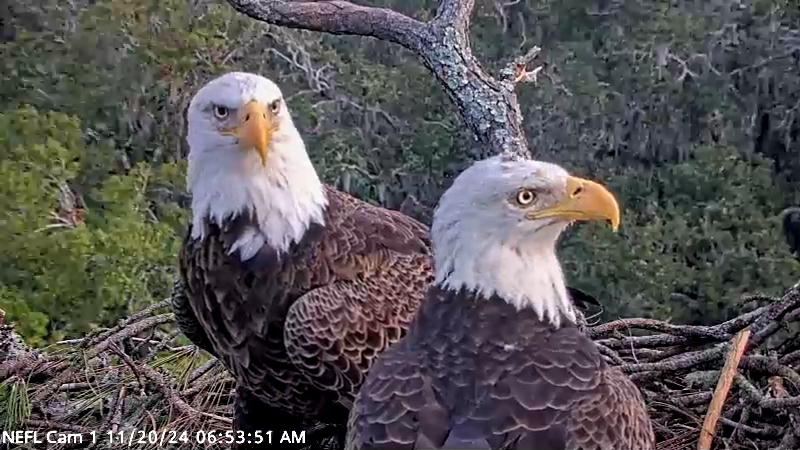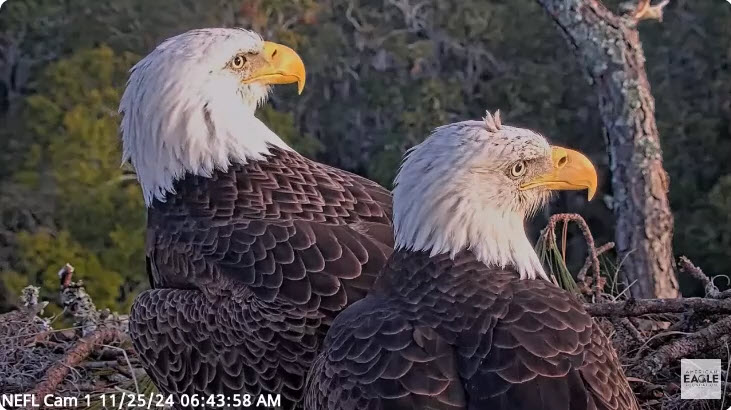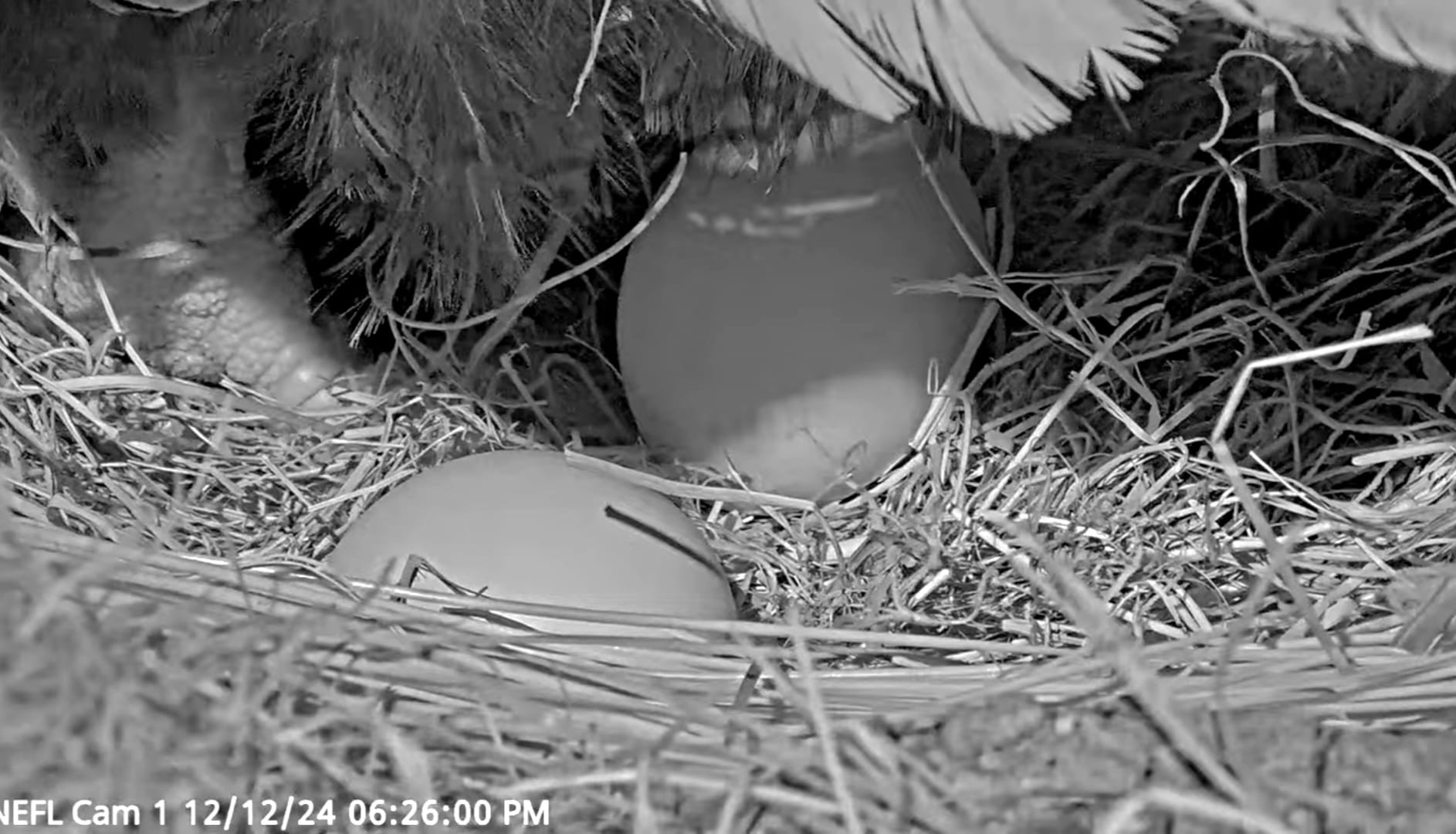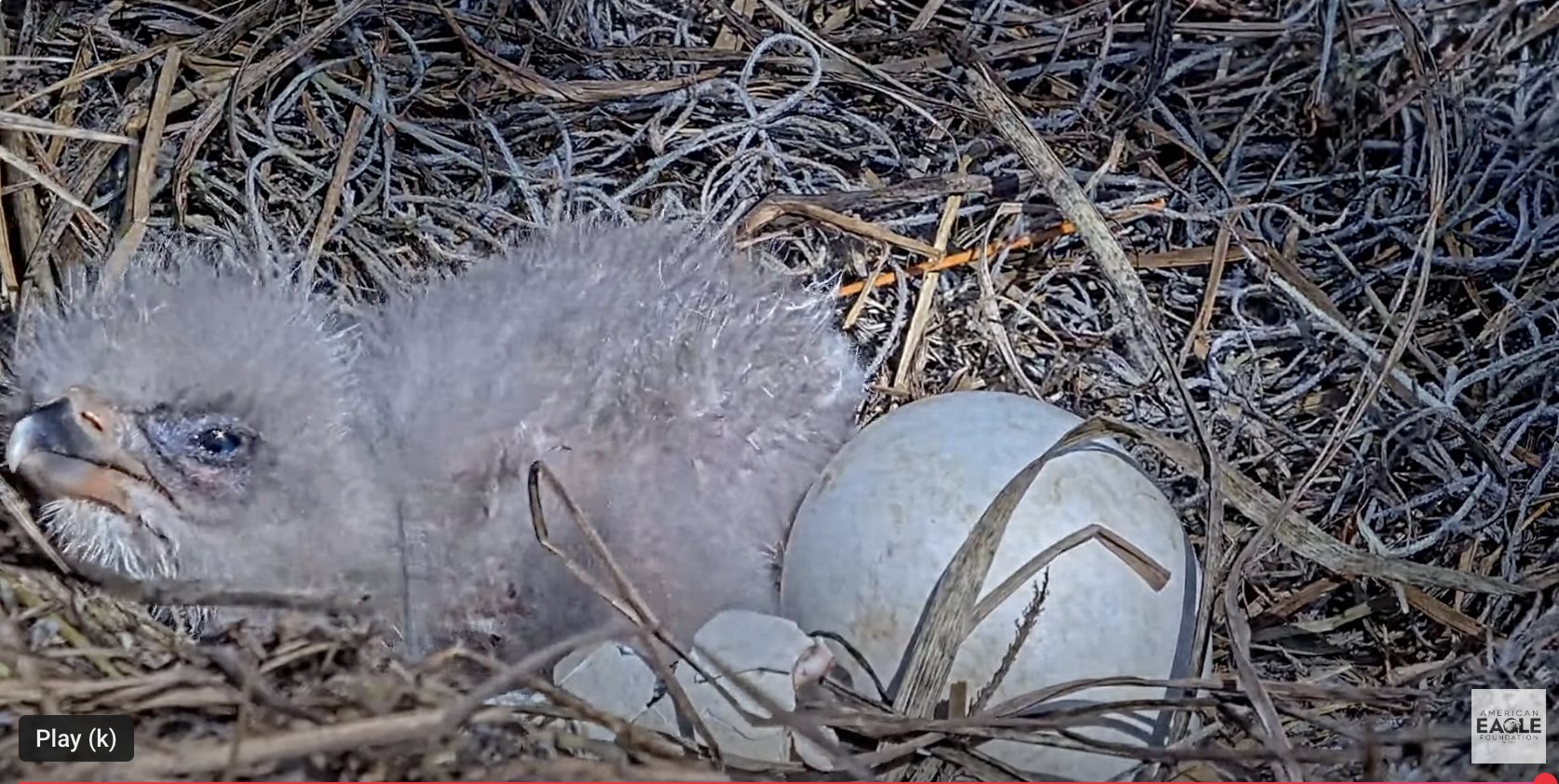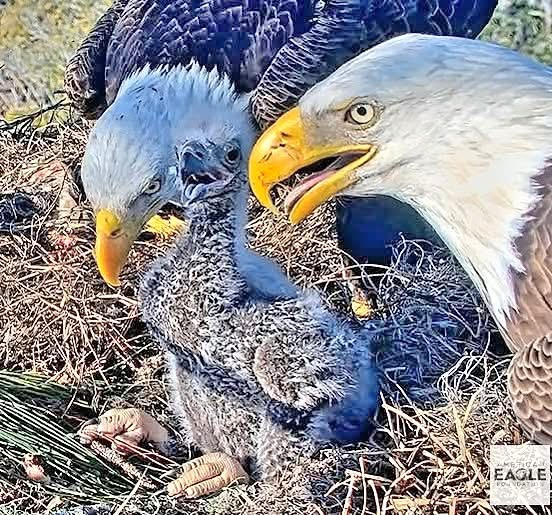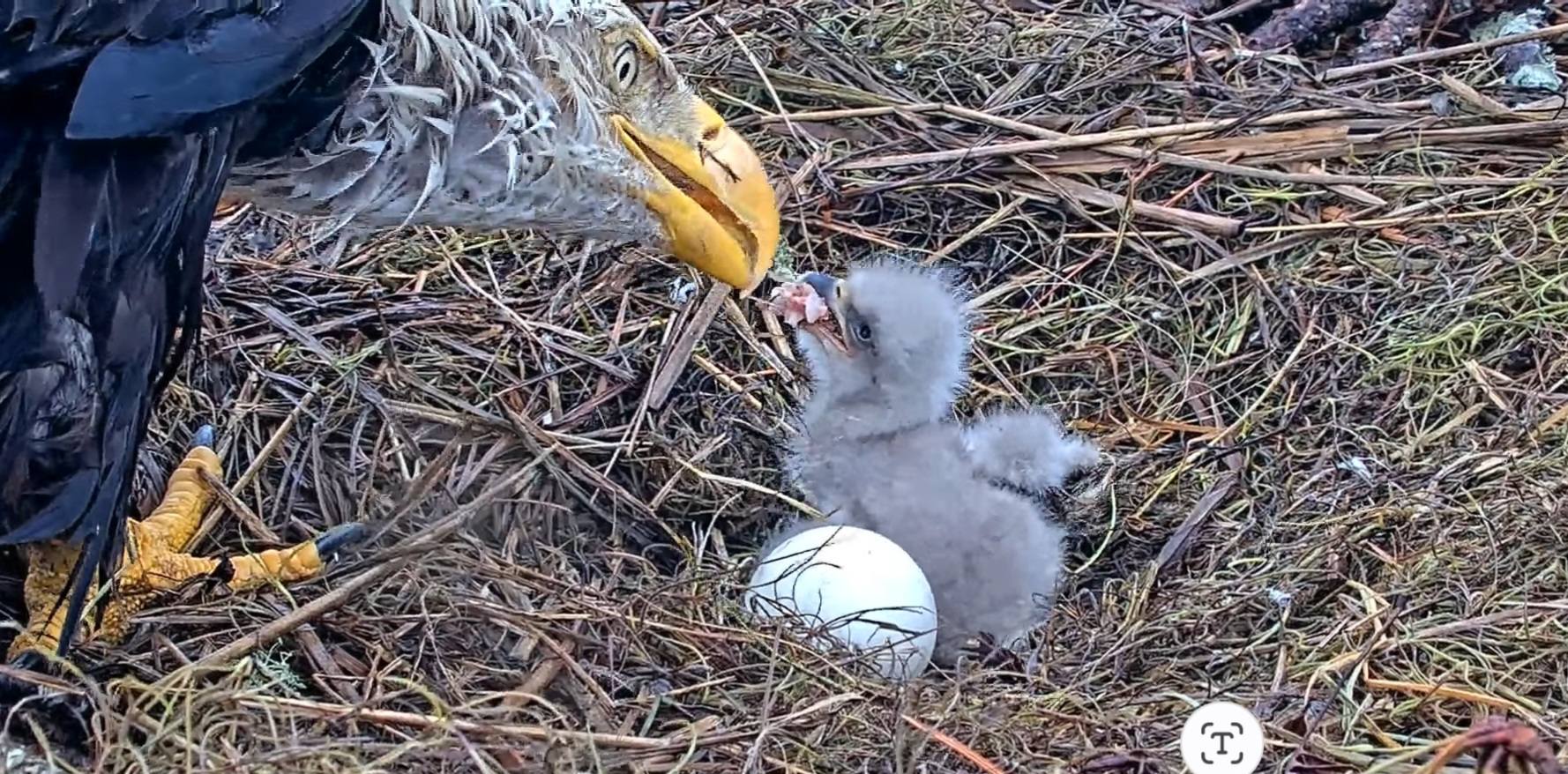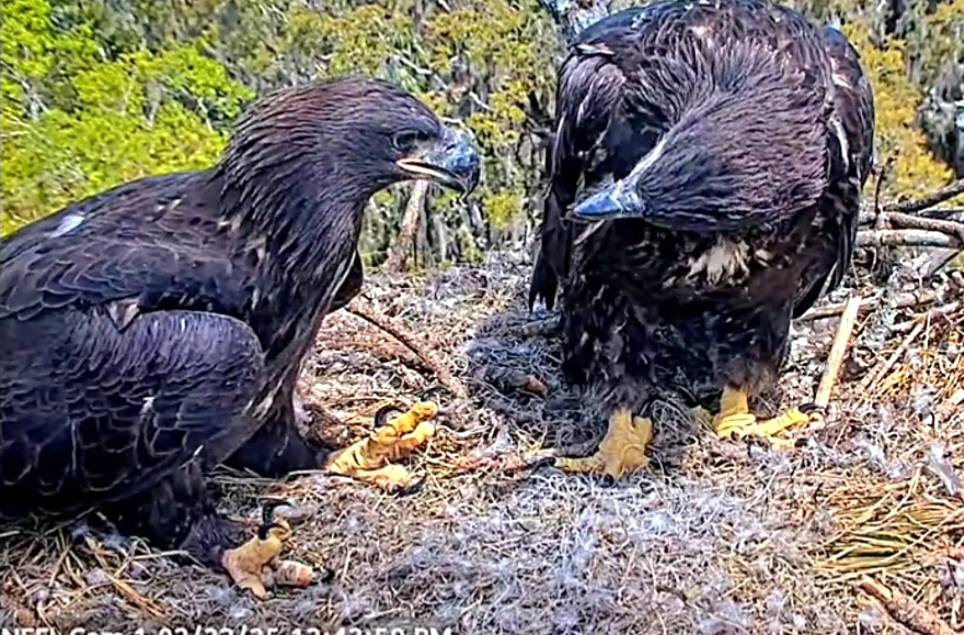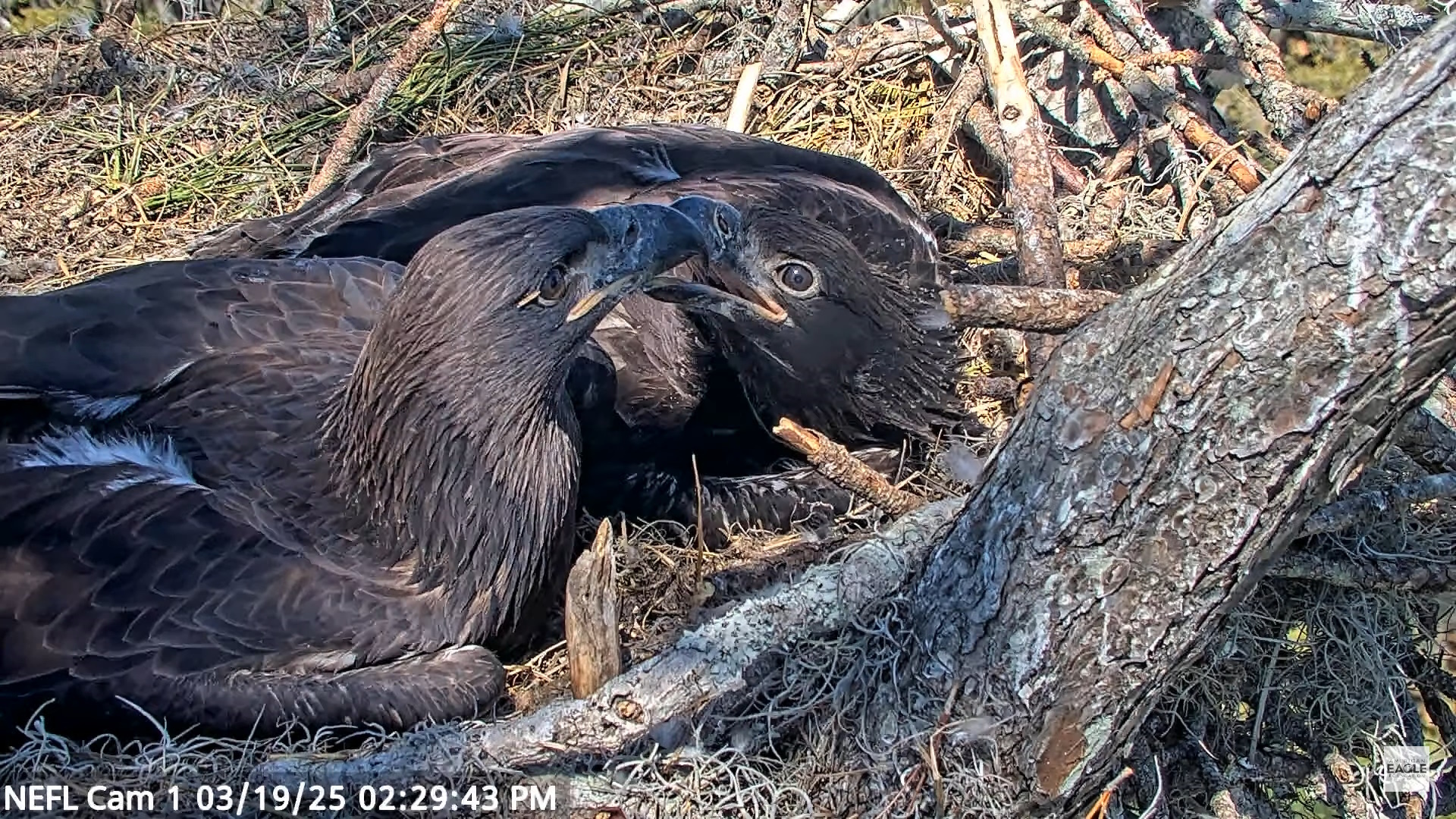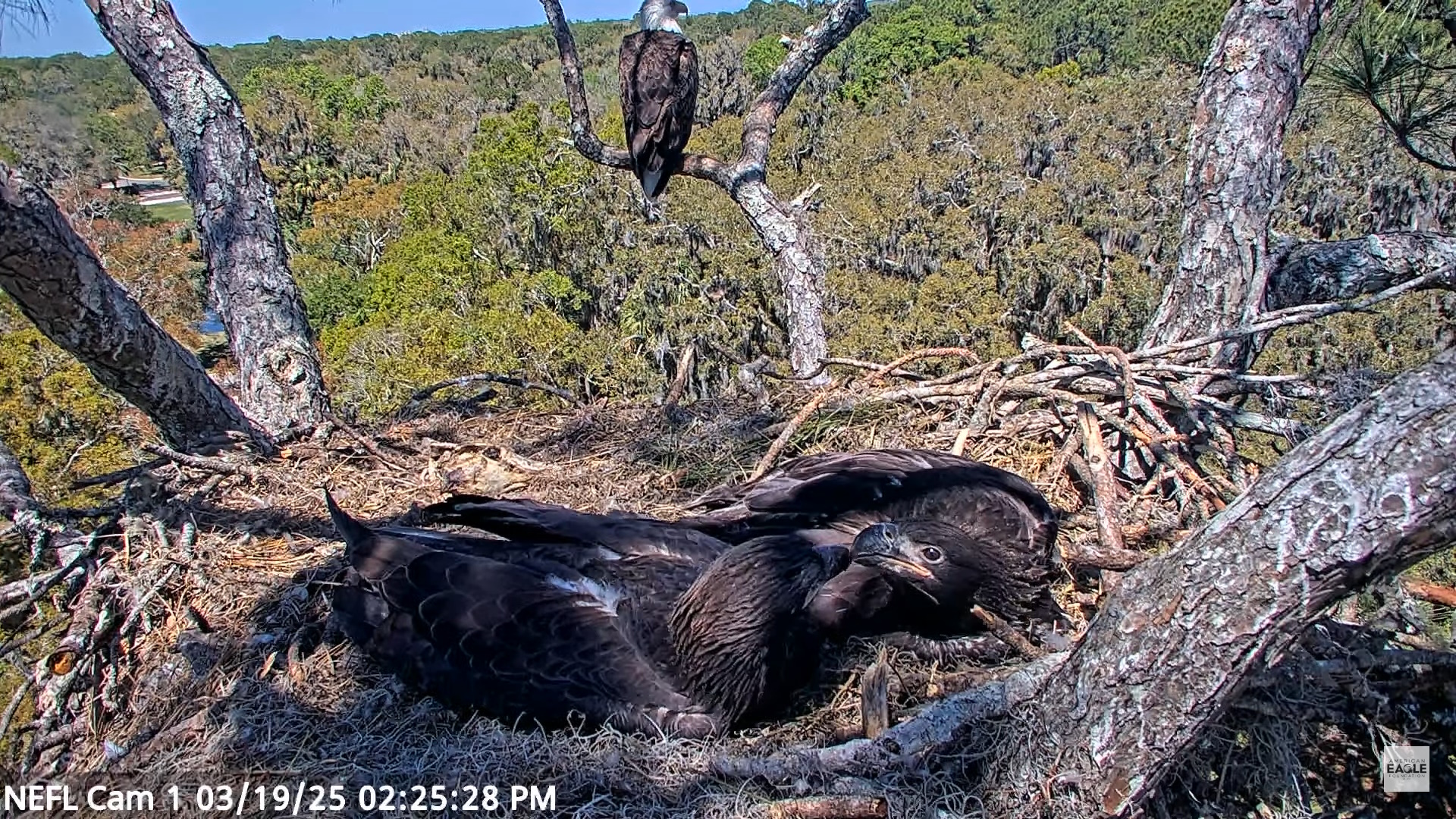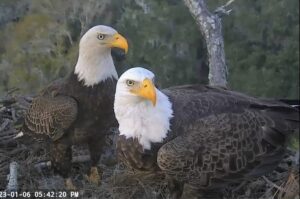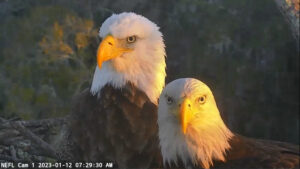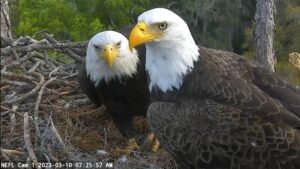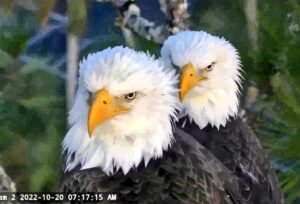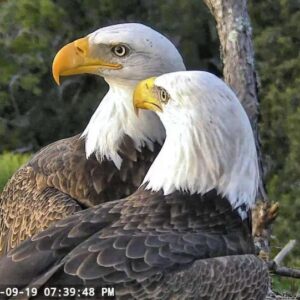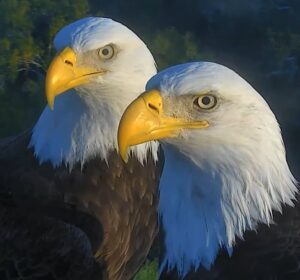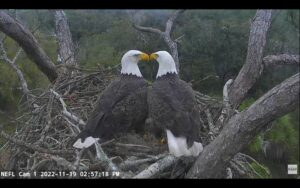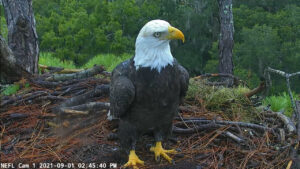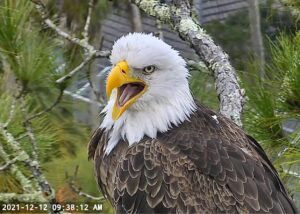Gabrielle & Beau
Bald Eagle Nest Cam
Northeast Florida

This is a wild eagle nest and anything can happen. While we hope that all eaglets hatched in this nest will grow up healthy and successfully fledge each season, things like sibling rivalry, predators, natural disaster as well as territorial disputes can affect this eagle family and may be difficult to watch.
Chat Information & Instructions
Chat can be found on the lower right side of the screen, just click the Discord  icon.
icon.
If the chat window is frozen and not scrolling, please refresh the page. You may need to do this a few times for chat to populate. For a smoother chat experience, please use the Discord app for PC, phone or tablet. Instructions are below
Chat Schedule (All times are EST)
Sunday 5pm – 6pm
Tuesday 7pm – 8pm
Wednesday 7pm – 8pm
Thursday 7pm – 8pm
The 2024-2025 Nesting Season
Gabby and Beau had another remarkable nesting season. Gabby laid two eggs, but only one hatched, giving us an eaglet that supporters later named Bodie through a fundraising campaign.
Then, on March 19, 2025, an unexpected twist unfolded. A fledgling eagle appeared at the nest. At first, there were a few scuffles between the newcomer, Bodie, and even Beau, but things quickly settled. The juvenile spent time coming and going freely, often lying beside Bodie or sharing meals with each other.
Though its origins remain unknown, the young eagle was clearly not ready to be on its own and began relying on Gabby and Beau for food and care. Remarkably, the adults’ instincts led them to accept and nurture this juvenile just as they did Bodie. The two young birds interacted much like siblings, giving viewers an extraordinary glimpse into the adaptability and resilience of bald eagle families.
This season has been a powerful reminder of the dynamic nature of eagle nesting behaviors and the remarkable ways these majestic birds rise to life’s surprises.
Swipe or use controls to change slides.
The 2023-2024 Nesting Season
Swipe or use controls to change slides.
V3 returned on August 31, 2023, with Gabrielle arriving shortly after on September 1, 2023.
The new pair began reinforcing and fortifying the nest this displaying of bonding behavior was a very positive sign of things to come for the new season.
Frequent mating was observed through late fall. Because of the male eagles dedication to Gabrielle, on 12-20-2023 V3 was Officially Named Beau.
Gabrielle laid eggs on 12-19-23 and 12-23-23.
On 12-22-23 Beau buried the first egg laid. Neither egg hatched but the pair continued bonding.
Several interlopers were seen in the area and on the nest, including sub-adults and adults, visited and occasionally.
The 2022-2023 Nesting Season
Swipe or use controls to change slides.
The 2022-2023 nesting season at NEFL started off with consistency and filled expectations. Samson arrived on August 9th, 2022 (same date as the previous year), and Gabrielle (Gabby) arrived on September 12th, 2022 (just as she did two out of the previous three years). They quickly re-kindled their bonding process through nestorations followed by frequent mating. All observations indicated early egg laying.
On November 24th, 2022, the neighborhood residents saw them mating at dusk in the Lumberyard (LY) soon after they had flown from the nest. Sadly, the last time Samson was seen, he was still perched in the Lumberyard seen by a resident. His unexpected disappearance came as quite a shock, as all indications looked positive. Samson was a special jewel, as he was an offspring of Romeo and Juliet who pioneered this nest. Many viewers saw Samson hatching on these live cams.
Within a week, visiting mature eagles started appearing at the nest. Up to twelve eagles were keenly and individually identified by the NEFL cam team. Gabby was not very receptive to most, but she did warm up to one eagle identified as V3 (Visitor #3) who first appeared at the nest on December 10th, 2022. Over the coming months Gabby and V3 became quite close, seen flying in and out of the nest together, and they were seen perching and roosting together off-site. V3 mirrored Samson in many ways. He was quite the nest protector yet a sweet eagle everyone grew to accept and love. Gabby and V3 were never seen mating, but they displayed all the indications of a “pair”.
Gabby left the Hamlet on her summer hiatus on May 6th, 2023. V3 remained in the area claiming and protecting the nest. He departed on May 15th, 2023. Although NEFL had a sad turning point early in the season, V3 brought joy back to Gabby and all the Hamlet viewers.
2021-2022 Season
As fall approached, our resident pair, Samson & Gabrielle (Gabby), returned right on schedule. Samson returned on August 9 and Gabby returned on September 12. They quickly started their “nestorations”, which is a huge part of their bonding process, delivering sticks, branches, and Spanish moss. This is their third season as a bonded pair, and they seem much more relaxed and in-tune to each other. Their nest “renovation” proves the skills they have achieved over the past two seasons.
They’ve frequently roosted through the night at the nest or in a tree together close by. It’s a joy seeing their union grow with the seasons. They’ve been seen mating and frequency increased as they lead us into the next part of the nesting season.
Gabby laid NE26 on December 17th at 5:18pm, shortly after Samson flew in with a fish and got his first view of the newly laid egg. On December 20th at 7:06pm NE27 was laid.
A pip was confirmed for NE26 on 1/22 at 8:20am, 19.75 hours later the hatch was complete on 1/23 at 4:06am. A pip was confirmed for NE27 on 1/24 at 5:03am, 21 hours later the hatch was complete on 1/25 at 2:24am.
Nest History
On October 1, 2013, the American Eagle Foundation (AEF) started providing live video streaming from a wild eagle nest located near the NE coast of Florida. The nest is located about 80 feet up in a Slash Pine tree and was built by Bald Eagles Romeo & Juliet approximately 12 years ago. Through the years, the nest has grown considerably in size and weight, likely weighing close to a ton. Since 2008, Gretchen Butler, Volunteer for Audubon “EagleWatch” Program and the American Eagle Foundation “Eagle Nest Cam” Program, has closely monitored and documented important events associated with the resident eagles Romeo & Juliet and their offspring.
As the 2019-2020 season unfolds, a new chapter will be written about this nest and its resident eagles, and we will be watching with you, as we all continue to learn more about Samson and Gabrielle.
Hail and Farewell
As our viewers will remember, since 2008 Gretchen Butler has been carefully keeping records of this Bald Eagle nest, located in Northeast Florida. The pattern of life in the Hamlet was predictable, with resident eagles, Romeo & Juliet, returning in early Fall to begin a new season, lay their eggs and raise eaglets to fledge. At the same time, they protected their nest from all intruders, keeping eggs and eaglets safe. They maintained an unprecedented 100% success rate over 10 seasons, raising 19 eaglets.
However, the 2018-2019 season was very different, as several large mature eagles disturbed the peace and tranquility of this nest. The expectations of the season ended in heartache as Juliet returned to the nest with an injury and was subsequently driven from the nest by a rival just days before the eggs were to hatch, leaving Romeo to do the work of two. When an egg hatched on Christmas Day 2018, a female eagle following Romeo to the nest swooped down and took the hatchling. This was not A2.
A2 continued to be seen with visiting male eagle, Samson, and they evolved into a bonded pair. For months, our viewers have called this beautiful eagle Gabby because she is so talkative, and in October 2019 she was officially given the elegant name Gabrielle by the NEFL team.
The Educational Impact of These Cams
The educational impact of our high-definition nest cams has been phenomenal, providing unprecedented insight into the Bald Eagle nesting process.
This season, we have to abandon our familiar expectations, as there are two new eagles laying claim to the nest. We will all watch with great anticipation as Samson and Gabrielle write a new chapter in the history of NEFL.
This project also focuses on conservation, habitat protection, and the dangers that eagles still face in the wild. In the end we will conserve only what we love, we will love only what we understand, and we will understand only what we are taught.
– Baba Dioum, International Union for the Conservation of Nature and Natural Resources.
To enhance the educational experience, a moderated chat is embedded on the cam page, allowing viewers to comment and ask questions about the eagles. Knowledgeable and friendly moderators help guide the discussion and provide insight. AEF also encourages students and groups who are studying eagles or related topics to reserve time in the chat where their questions can be answered.
This has been a hugely successful endeavor, and we have welcomed many classrooms with students of all ages. Teachers across the nation have written us with glowing compliments about the positive impact this experience has had on their students.
About Our Cams
One 4K cam and three high-definition cams are available on this page. Three are mounted on the nest tree and provide different views of the nest. One cam is mounted on a nearby tree at a lower angle and provides a long range view of the nest tree and the canopy. If you watch for a while, you may be lucky enough to see eagles flying to and from the tree, and when the eaglets get to a certain size, you will see them begin to branch and ultimately fledge the nest.
The four video cam views are accessed by clicking on “Other Views,” located at the bottom right of the screen when hovering over the video screen. The four views will be shown at the bottom of the screen as thumbnails, and you can simply click the view you want to watch.
At night, an infrared light is turned on. The eagles cannot see this light; it is outside their visible spectrum of light. Neither can humans. If you were at the nest site, looking up at the tree at night, you would only see light from the moon or stars. The infrared light is converted into visible light (black and white) by the camera.

